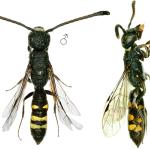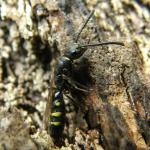Identification keys and general biology are given in Malyshev (1968), Richards (1980), Gauld & Bolton (1988), Falk (1991) and Yeo & Corbet (1995).
There are widely scattered records from Cornwall to Kent and north to North-west Yorkshire. Not found on the Channel Islands or in Ireland.
Overseas, found in many parts of Europe (Norway, Sweden, Finland, Denmark, The Netherlands, France, Germany, Italy), North Africa and Asia (Turkey, Caucasus).
A Nationally Notable (Nb) species (Falk, 1991).
Found around dead wood such as posts, old trees and stumps in sunny situations, which are the nesting sites of its hosts (see below). Recorded from a wide variety of habitats: lowland heaths and sandy places, river margins, limestone grasslands, clay woodlands, fenland, parkland, coastal areas and gardens.
Probably univoltine ; adults most likely to be seen during June, and sometimes in May and July.
No information available
No information available.
1998



